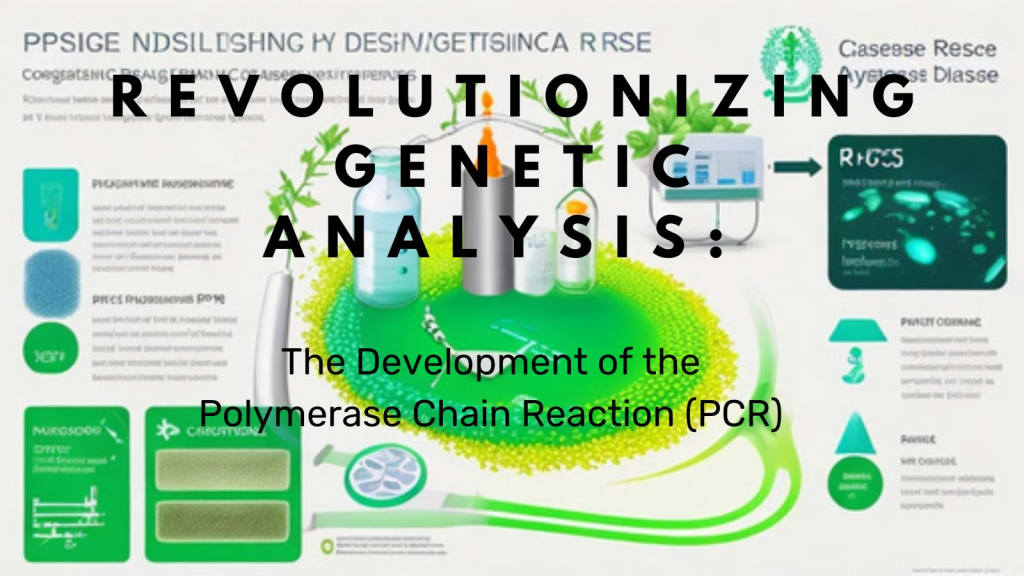Revolutionizing Genetic Analysis:
The Development of the Polymerase Chain Reaction (PCR)

Introduction:
In the field of sub-atomic biology, hardly any procedures significantly affect logical exploration and diagnostics as the Polymerase Chain Reaction (PCR). This progressive strategy, spearheaded by Kary B. Mullis during the 1980s, has changed the manner in which we concentrate on DNA and has become an indispensable apparatus in different fields, from clinical diagnostics to legal science.
In this article, we dig into the development of PCR, its standards, and its remarkable contributions to genetic analysis.
The Requirement for Amplification:
Early difficulties in DNA analysis:
Before PCR, researchers confronted a few restrictions in concentrating on DNA. Customary strategies for DNA amplification, like cloning, were time-consuming and wasteful.
The limits of conventional strategies:
Cloning required complex systems and was restricted by the availability of proper limitation compounds. It was not feasible for enhancing little DNA tests or dissecting explicit DNA locales.
The interest in a robust amplification procedure:
Researchers perceived the requirement for a strategy that could quickly and precisely enhance explicit DNA sections, taking into consideration a great many applications, including genetic exploration, clinical diagnostics, and measurable analysis.
The Birth of PCR:
Kary B. Mullis: A visionary researcher:
Kary B. Mullis, an American biochemist, made critical contributions to sub-atomic biology. His work on PCR procured him the Nobel Prize in Science in 1993.
The Aha Second Mullis' disclosure: In 1983, while driving along a California parkway, Mullis had an aha second that prompted the conceptualization of PCR. He realized that a basic DNA amplification technique could be accomplished by rehashed patterns of warming and cooling DNA tests.
The conceptualization of the Polymerase Chain Reaction:
Mullis planned a strategy utilizing DNA polymerase, short DNA primers, and thermal cycling to intensify explicit DNA groupings dramatically.
The PCR Cycle:
Thermal cycling: The underpinning of PCR:
PCR includes a progression of temperature changes to work with DNA denaturation, groundwork strengthening, and DNA synthesis. The interaction regularly comprises three stages: denaturation, tempering, and expansion.
Denaturation, strengthening, and expansion ventures:
During denaturation, the DNA double helix is warmed to isolate the strands. In the tempering step, DNA primers bind to correlative groupings on each strand. Expansion happens when DNA polymerase synthesizes new DNA strands involving the primers as layouts.
The job of DNA polymerase and primers:
DNA polymerase is a key chemical that synthesizes new DNA strands. Primers are short DNA successions that give a beginning stage to DNA synthesis.
Rehashed cycles: Enhancing DNA dramatically:
The three-step pattern of denaturation, tempering, and augmentation is rehashed on numerous occasions, bringing about outstanding amplification of the DNA locale of interest.
Applications of PCR:
Genetic examination: Opening the mysteries of DNA:
PCR has altered genetic exploration by enabling the amplification of explicit DNA districts for sequencing, change analysis, and quality articulation studies.
Clinical diagnostics:
Quick and touchy discovery of illnesses: PCR-based symptomatic tests, like those for irresistible sicknesses and genetic issues, have further developed infection identification, taking into account early intercession and customized therapy.
Legal science: Tackling violations through DNA analysis:
PCR is instrumental in criminological DNA analysis, enabling the amplification of moment DNA tests found at crime locations, which can be utilized for ID and proof.
Transformative biology:
The following family concentrates on genetic variety: PCR has assisted analysts with concentrating on developmental connections, populace genetics, and biodiversity by enhancing and breaking down unambiguous DNA markers.
Progressions in PCR Innovation:
Real-time PCR:
Checking DNA amplification in real-time: Real-time PCR, otherwise called quantitative PCR (qPCR), considers the evaluation of DNA amplification as it works out. This innovation has altered quality articulation analysis, viral burden estimation, and identification of genetic abnormalities.
Reverse Transcription PCR (RT-PCR):
Dissecting RNA with PCR: RT-PCR combines reverse transcription of RNA into corresponding DNA (cDNA) and subsequent PCR amplification. It has become a foundation method for concentrating on quality articulation, RNA infections, and distinguishing RNA-based biomarkers.
Nested PCR: Upgrading specificity and sensitivity:
Nested PCR includes two rounds of PCR amplification, where the result of the main round becomes the layout for the subsequent round. This method improves the specificity and sensitivity of DNA amplification, especially while working with low-abundance targets.
Multiplex PCR:
Concurrent amplification of various targets: Multiplex PCR considers the amplification of numerous DNA focuses in a solitary reaction. Utilizing various arrangements of primers, enables the concurrent recognition of different genetic markers, saving time and assets.
PCR Innovations and Effect:
Scaling down and computerization:
Further developing proficiency and throughput: PCR has benefited from progressions in scaling down and robotization, enabling high-throughput analysis and diminishing reagent utilization. Microfluidic PCR gadgets and robotic frameworks have reformed DNA amplification in exploration and diagnostics.
Digital PCR:
Absolute evaluation of DNA: Digital PCR segments DNA into numerous singular reactions, considering the absolute measurement of DNA targets. This innovation has critical applications in uncommon change identification, duplicate number variety analysis, and deciding viral burden.
Isothermal amplification strategies:
Options in contrast to temperature cycling: A few isothermal amplification techniques, for example, circle interceded isothermal amplification (Light) and recombinase polymerase amplification (RPA), have been created as options in contrast to PCR. These methods improve amplification processes by taking out the requirement for thermal cycling.
Future Headings and Possibilities:
Point-of-care PCR:
Bringing diagnostics to the field: The development of portable, easy-to-use PCR gadgets can possibly stretch out DNA analysis capabilities to distant areas and asset-restricted settings, taking into consideration fast sickness conclusion and observation.
Next-generation sequencing (NGS) and PCR joining:
PCR assumes an essential part in getting ready DNA libraries for NGS, a useful asset for genome sequencing and concentrating on genetic varietion. The reconciliation of PCR with NGS has opened new roads for genomic research and customized medication.
Upgraded specificity and sensitivity:
Further developing PCR execution: Progressing research centers around working on the specificity and sensitivity of PCR through original catalysts, adjusted nucleotides, and high-level preliminary plan calculations. These headways will improve the discovery of low-abundance targets and limit bogus positive outcomes.
Conclusion:
The development of the Polymerase Chain Reaction (PCR) has changed genetic analysis and has become a fundamental apparatus in various logical disciplines. This method, conceptualized by Kary B. Mullis, enables the quick and precise amplification of explicit DNA areas, opening ways to groundbreaking disclosures in genetics, clinical diagnostics, legal science, and developmental biology. As PCR innovation keeps on developing, we can expect much more remarkable headways that will shape the fate of genetic exploration and upgrade how we might interpret the complex universe of DNA.
About the Creator
Literary fusion
Welcome to literary fusion where art and literature intertwine to create a vibrant tapestry. I am [Abdullah Shabir], an artist and writer exploring self-expression through colors and carefully chosen words.






Comments
There are no comments for this story
Be the first to respond and start the conversation.